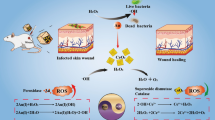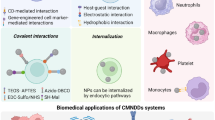Abstract
Liver fibrosis, resulting from chronic liver damage and characterized by the accumulation of extracellular matrix (ECM) proteins, is a characteristic of most types of chronic liver diseases. The activation of hepatic stellate cells (HSC) is considered an essential pathological hallmark in liver fibrosis. Although nitric oxide (NO) can effectively induce HSC apoptosis, the systemic administration of NO is ineffective and may cause severe complications such as hypotension. To overcome this limitation, nanoparticles were designed to target HSCs and release NO locally under the exposure of near infrared light (NIR). To achieve this, upconversion nanoparticle (UCNP) cores were enveloped in mesoporous silica shells (UCNP@mSiO2), which were modified with hyaluronic acid (HA-UCNP@mSiO2) and Roussin’s black salt (RBS). HA molecules recognize and bind to CD44 proteins, which are overexpressed on activated HSCs. Under exposure to a 980-nm NIR laser, the UCNP cores convert the 980-nm wavelength into ultraviolet (UV) light, which then energizes the RBS (NO donors), resulting in an efficient release of NO inside of the HSCs. Once released, NO triggers HSC apoptosis and reverses the liver fibrosis. This targeted and controlled release method provides the theoretical and experimental basis for novel therapeutic approaches to treat hepatic fibrosis.

Similar content being viewed by others
References
Marrone, G; Shah, V. H.; Gracia-Sancho, J. Sinusoidal communication in liver fibrosis and regeneration. J. Hepatol.2016, 65, 608–617.
Bataller, R.; Brenner, D. A. Liver fibrosis. J. Clin. Invest.2005, 115, 209–218.
Lee, Y. A.; Wallace, M. C.; Friedman, S. L. Pathobiology of liver fibrosis: A translational success story. Gut2015, 64, 830–841.
Fausther, M.; Lavoie, E. G.; Dranoff, J. A. Contribution of myofibroblasts of different origins to liver fibrosis. Curr. Pathobiol. Rep.2013, 1, 225–230.
Kisseleva, T.; Uchinami, H.; Feirt, N.; Quintana-Bustamante, O.; Segovia, J. C.; Schwabe, R. F.; Brenner, D. A. Bone marrow-derived fibrocytes participate in pathogenesis of liver fibrosis. J. Hepatol.2006, 45, 429–438.
Guyot, C.; Lepreux, S.; Combe, C.; Doudnikoff, E.; Bioulac-Sage, P.; Balabaud, C.; Desmoulière, A. Hepatic fibrosis and cirrhosis: The (myo)fibroblastic cell subpopulations involved. Int. J. Biochem. Cell Biol.2006, 38, 135–151.
Wells, R. G. Portal fibroblasts in biliary fibrosis. Curr. Pathobiol. Rep.2014, 2, 185–190.
Friedman, S. L. Hepatic stellate cells: Protean, multifunctional, and enigmatic cells of the liver. Physiol. Rev.2008, 88, 125–172.
Zhang, D. Y.; Friedman, S. L. Fibrosis-dependent mechanisms of hepatocarcinogenesis. Hepatology2012, 56, 769–775.
Wang, Y.; Du, J.; Niu, X.; Fu, N.; Wang, R.; Zhang, Y.; Zhao, S.; Sun, D.; Nan, Y. MiR-130a-3p attenuates activation and induces apoptosis of hepatic stellate cells in nonalcoholic fibrosing steatohepatitis by directly targeting TGFBR1 and TGFBR2. Cell Death Dis.2017, 8, e2792.
Ezhilarasan, D.; Sokal, E.; Najimi, M. Hepatic fibrosis: It is time to go with hepatic stellate cell-specific therapeutic targets. Hepatobiliary Pancreat. Dis. Int.2018, 17, 192–197.
Langer, D. A.; Das, A.; Semela, D.; Kang-Decker, N.; Hendrickson, H.; Bronk, S. F.; Katusic, Z. S.; Gores, G. J.; Shah, V. H. Nitric oxide promotes caspase-independent hepatic stellate cell apoptosis through the generation of reactive oxygen species. Hepatology2008, 47, 1983–1993.
Dai, L.; Ji, H.; Kong, X. W.; Zhang, Y. H. Antifibrotic effects of ZK14, a novel nitric oxide-donating biphenyldicarboxylate derivative, on rat HSC-T6 cells and CCL4-induced hepatic fibrosis. Acta Pharmacol. Sin.2010, 37, 27–34.
Duong, H. T. T.; Dong, Z. X.; Su, L.; Boyer, C.; George, J.; Davis, T. P.; Wang, J. H. The use of nanoparticles to deliver nitric oxide to hepatic stellate cells for treating liver fibrosis and portal hypertension. Small2015, 11, 2291–2304.
Hetrick, E. M.; Shin, J. H.; Paul, H. S.; Schoenfisch, M. H. Anti-biofilm efficacy of nitric oxide-releasing silica nanoparticles. Biomaterials2009, 30, 2782–2789.
Duong, H. T. T.; Adnan, N. N. M.; Barraud, N.; Basuki, J. S.; Kutty, S. K.; Jung, K.; Kumar, N.; Davis, T. P.; Boyer, C. Functional gold nanoparticles for the storage and controlled release of nitric oxide: Applications in biofilm dispersal and intracellular delivery. J. Mater. Chem. B2014, 2, 5003–5011.
Dong, K.; Ju, E. G.; Gao, N.; Wang, Z. Z.; Ren, J. S.; Qu, X. G. Synergistic eradication of antibiotic-resistant bacteria based biofilms in vivo using a NIR-sensitive nanoplatform. Chem. Commun.2016, 52, 5312–5315.
Tian, G.; Ren, W. L.; Yan, L.; Jian, S.; Gu, Z. J.; Zhou, L. J.; Jin, S.; Yin, W. Y.; Li, S. J.; Zhao, Y. L. Red-emitting upconverting nano-particles for photodynamic therapy in cancer cells under near-infrared excitation. Small2013, 9, 1929–1938.
Wang, C.; Cheng, L.; Liu, Y. M.; Wang, X. J.; Ma, X. X.; Deng, Z. Y.; Li, Y. G.; Liu, Z. Imaging-guided pH-sensitive photodynamic therapy using charge reversible upconversion nanoparticles under near-infrared light. Adv. Funct. Mater.2013, 23, 3077–3086.
Yan, Z. Q.; Qin, H. S.; Ren, J. S.; Qu, X. G. Photocontrolled multidirectional differentiation of mesenchymal stem cells on an upconversion substrate. Angew. Chem., Int. Ed.2018, 57, 11182–11187.
Cheng, L.; Yang, K.; Zhang, S.; Shao, M. W.; Lee, S.; Liu, Z. Highly-sensitive multiplexed in vivo imaging using pegylated upconversion nanoparticles. Nano Res.2010, 3, 722–732.
Höchst, B.; Schildberg, F. A.; Sauerborn, P.; Gäbel, Y. A.; Gevensleben, H.; Goltz, D.; Heukamp, L. C.; Türler, A.; Ballmaier, M.; Gieseke, F. et al. Activated human hepatic stellate cells induce myeloid derived suppressor cells from peripheral blood monocytes in a CD44-dependent fashion. J. Hepatol.2013, 59, 528–535.
Urashima, S.; Tsutsumi, M.; Ozaki, K.; Tsuchishima, M.; Shimanaka, K.; Ueshima, Y.; Takase, S. Immunohistochemical study of hyaluronate receptor (CD44) in alcoholic liver disease. Alcohol. Clin. Exp. Res.2000, 24, 34S–38S.
Zhou, X. H.; Zheng, P. L.; Jin, Y.; Zhao, W. C.; Li, Z. H. A biocompatible strategy for the construction of cell patch using upconversion nanoparticles-conjugated mesenchymal stem cells. Mater. Lett.2018, 221, 131–134.
Peng, F.; Tee, J. K.; Setyawati, M. I.; Ding, X. G.; Yeo, H. L. A.; Tan, Y. L.; Leong, D. T.; Ho, H. K. Inorganic nanomaterials as highly efficient inhibitors of cellular hepatic fibrosis. ACS Appl. Mater. Interfaces2018, 10, 31938–31946.
Acknowledgements
This work was supported by the American Heart Association (Nos. 18TPA34230092 and 19EIA34660 286 to K. C.), the National Natural Science Foundation of China (No. U1904149 to H. X. L.), National S&T Major Project of China (No. 2018ZX10301201-008 to Z. G. R.) and the High Technology Research and Development Program of Henan Province (No. 20A320055 to H. X. L.).
Author information
Authors and Affiliations
Corresponding authors
Electronic Supplementary Material
Rights and permissions
About this article
Cite this article
Liang, H., Li, Z., Ren, Z. et al. Light-triggered NO-releasing nanoparticles for treating mice with liver fibrosis. Nano Res. 13, 2197–2202 (2020). https://doi.org/10.1007/s12274-020-2833-6
Received:
Revised:
Accepted:
Published:
Issue Date:
DOI: https://doi.org/10.1007/s12274-020-2833-6




